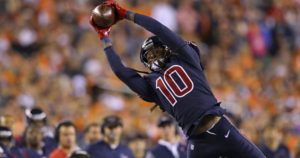The 2019 Blueprint to the Zero RB Draft Strategy
Draft season–it’s the most wonderful time of the fantasy football year. Hope springs eternal. We get out our notebooks, laptops, and rankings, with the hopes of putting together the next great juggernaut. But before we begin our drafts, we must prepare our strategy. The most intriguing strategy used by fantasy gamers on draft day, is the Zero RB. It also carries the most risk and takes the most skill to pull off. For those daring enough to try it, preparation is key.
The Zero RB Strategy And When To Use it
Zero RB does not mean drafting no running backs. It just means zero running backs for the first five rounds. After that, we begin building our stable of running backs. The Zero RB strategy has become more popular as NFL offenses take advantage of rule changes in the passing game. It’s also due to first-round running backs busting at an average rate of 42-percent over the last three years. This is the percentage of first round RBs finishing outside of the top-12. Due to this, fantasy gamers have become leery of spending the draft capital on the position. (Credit Jon Fineour)
🚨🏈Podcast ACTIVATE🚨🏈
Special guest @MattReller joins me to make the case for zero RB.
🔐 It In! #FantasyFootball
@createArank https://t.co/007McxgfT6— ZVM (@ThatSegaDude) June 9, 2019
There’s a growing number of people that believe running backs don’t matter. These people love the Zero RB strategy. They also tend to play in points per reception leagues. In a standard scoring format, I would not recommend employing this strategy. Draft position also plays a role in deciding which strategy to use. For 2019, the Zero RB strategy is best employed from a draft position between fifth and eighth in a 12-team league. The top four picks will typically be the stud bell-cow running backs.
After they are gone, players like DeAndre Hopkins and Davante Adams should be your targets. Hopkins accounted for 32-percent of the Texans’ targets and 42-percent of the team’s receiving touchdowns in 2018. Adams accounted for 28-percent of the Packers’ targets and 52-percent of their receiving touchdowns. These two players are the current consensus top-two WRs.
 Pairing one of these top guys with a receiver either in the next tier or the one below, would give you a strong WR corps that would need minimal shuffling on a week-to-week basis. Names like Adam Thielen, Keenan Allen, T.Y. Hilton and Mike Evans spring to mind.
Pairing one of these top guys with a receiver either in the next tier or the one below, would give you a strong WR corps that would need minimal shuffling on a week-to-week basis. Names like Adam Thielen, Keenan Allen, T.Y. Hilton and Mike Evans spring to mind.
Gain A Positional Advantage
The Zero RB strategy provides the flexibility to use high draft capital on a top-three tight end. The drop from the big three is a steep one. Travis Kelce, George Kittle, and Zach Ertz are like Adams and Hopkins in that they are going to be near the top of their teams’ targets and red zone opportunities. Using this strategy also allows us to spend on a quarterback. Gaining the advantage at both QB and TE are what make this draft strategy appealing to me. After the top four at QB, much like TE, there are a lot of question marks surrounding the remaining options. Patrick Mahomes, Deshaun Watson, Andrew Luck, and Aaron Rodgers are all in wide-open passing attacks. They each offer rushing touchdown opportunity as well.
 Running Backs To Target
Running Backs To Target
Starting in round six, it’s time to start building our stable of running backs. For this strategy to pay off, look for running backs that perform well in the passing game. James White, Nyheim Hines, Rashaad Penny, and Tevin Coleman are the names that standout to me as fitting this bill. Historically, the running backs that turn in top-24 performances and are drafted after round five, do so on the back of receptions and receiving yards. The rest, find themselves in a starting job based on injury or out-playing their veteran teammates. Fitting in this category this year are guys like Royce Freeman, Damien Harris, Ronald Jones, and Matt Breida. Others to consider in the middle-to-late rounds are Darrell Henderson, Justice Hill, Latavius Murray, and Kenyan Drake. Identifying values as they become available throughout the draft will help bolster the roster at all positions.
It is encouraged to try out different strategies from different positions in mock drafts. Doing this “homework” now in June and July will only help you build the rosters that will win championships in December.





